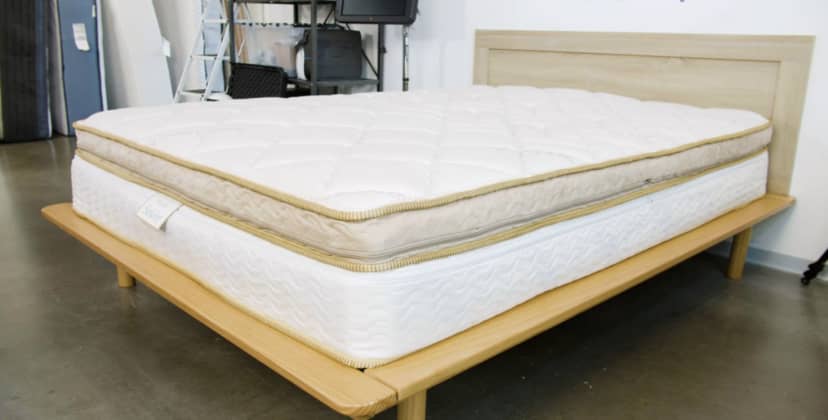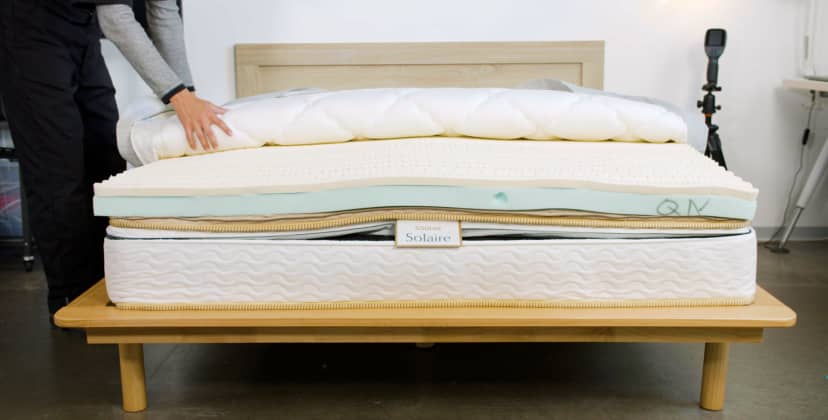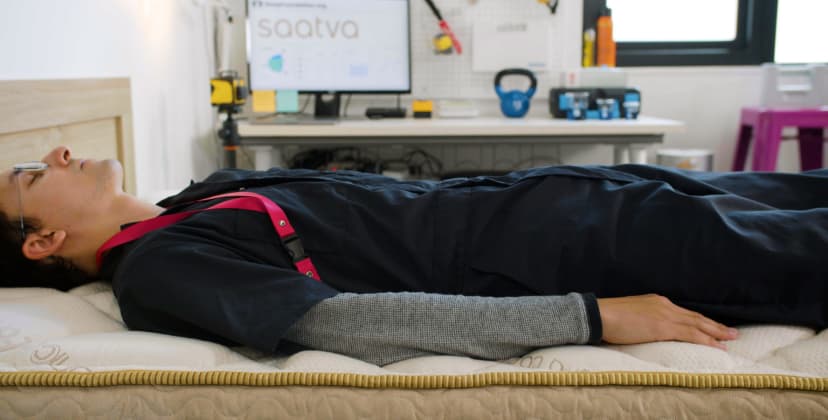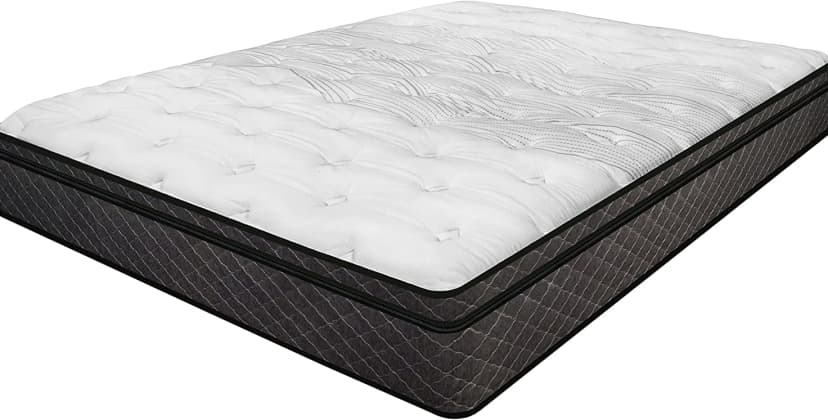When you buy through our links, we may earn a commission. Products or services may be offered by an affiliated entity. Learn more.
Airbed mattresses offer unparalleled levels of customization and personalized comfort. Instead of coils or foam, these models are constructed with air chambers in their support cores. By adding air to one of the chambers, you can make the mattress feel firmer. Releasing air creates a softer feel. Most airbeds have at least two chambers – one for each side of the mattress – but some have six or more to create an even more customized feel. Airbeds are a great fit if you love customization and have a flexible budget.
- A lifetime warranty and free White Glove delivery are just icing on the cake for our top pick, the Solaire airbed. We loved the ability to optimize comfort with 50 firmness settings.
- When choosing an airbed, there’s even more to consider than with your typical mattress. Read more on how to choose in our guide.
- If you’re ready to get to the reviews, catch up quickly with our 1-minute videos.
Our Top Picks
-
Best Overall Mattress – Solaire
View Details
-
Best Value Mattress – InnoMax Harmony Airbed
View Details
Swipe for more
Best Overall Mattress
Solaire
8.7 /10
Test Lab Score
$300 off mattress purchases of $1,000 or more
$300 off mattress purchases of $1,000 or more
The Solaire Mattress is a runaway winner for the best overall airbed mattress. Built with high-quality materials, it offers 50 firmness settings and exceptional performance from pressure-relieving comfort layers.




Credit: Sleep Foundation Test Lab
Price
$3,745
Mattress Type
Airbed
Firmness Options
Soft (3), Medium Soft (4), Medium (5), Medium Firm (6), Firm (7) Firm (8)
Trial Period
365 Nights ($99 Return Fee)
Full Details
Who It’s Best For
Because of how easy it is to adjust the firmness, the Solaire suits almost any sleeper. It is especially popular among couples since each person can set their side of the mattress to the firmness level that they prefer.
Feel
Firmness on the Solaire ranges from soft (3) to firm (8), and the comfort layers offer gentle cradling of your pressure points without too much sink or hug.
What It’s Made Of
The Solaire has a 3-inch Euro-top made with quilted fabric along with a 1 inch of latex and 2 inches of gel-infused memory foam. Beneath these comfort layers is the vulcanized rubber airbed layer that includes distinct inflatable chambers for each side of the bed. The cover is made of organic cotton.
What We Don’t Like
The price of the Solaire exceeds the budget of many shoppers. If you opt to return the mattress, you have to pay $99 for return shipping.
Scoring Breakdown
The following ratings show how suitable this mattress is for different sleeping positions and sleeper weights. These scores are determined by how well the mattress supports and relieves pressure for each sleeper type.
Best Value Mattress
InnoMax Harmony Airbed
8.9 /10
Test Lab Score
$1,600 from InnoMax (queen)
$1,600 from InnoMax (queen)
The InnoMax Harmony Airbed gives you all the key features that you need in an airbed at a price that won’t bust your budget. It has 50 firmness levels that you control with a remote, a dual-sided design for separate firmness settings, and a comfortable foam-filled pillow-top.

Price
$1,600
Mattress Type
Airbed
Firmness Options
Soft (3), Medium Soft (4), Medium (5), Medium Firm (6), Firm (7) Firm (8)
Trial Period
Varies by seller
Full Details
Who It’s Best For
The InnoMax Harmony is best for people who want a straightforward airbed that is available at a competitive price. With its modifiable firmness, it suits sleepers of every position and weight.
Feel
The feel of the InnoMax Harmony is inviting and customizable. You can quickly adjust the firmness level, and you’ll notice moderate contouring of your body by the foam in the pillow-top.
What It’s Made Of
This mattress is designed without a lot of bells and whistles. Its top layers include a pillow-top that is quilted with adaptive foam. It has a moisture barrier that sits above the air chambers that are inflated by a hose designed to be durable and free of kinks.
What We Don’t Like
You are responsible for assembling the mattress yourself. The foam layers can give off a “new mattress smell” that is detectable for up to a few days after the mattress is installed.
Scoring Breakdown
The following ratings show how suitable this mattress is for different sleeping positions and sleeper weights. These scores are determined by how well the mattress supports and relieves pressure for each sleeper type.
Best Mattress for Pressure Relief
iSense Hybrid Premier
8.6 /10
Test Lab Score
20% off sitewide
20% off sitewide
The iSense Hybrid Premier is our top pick if you want standout pressure relief to go along with the adjustable firmness of an airbed. It has a unique hybrid design that lets you control the firmness level, and its thick foam layers also cushion key areas of the body to support spinal alignment.

Credit: Sleep Foundation Test Lab
Price
$3,999
Mattress Type
Hybrid
Firmness Options
Soft (3), Medium Soft (4), Medium (5), Medium Firm(6), Firm (7)
Trial Period
180 Night (45-night requirement)
Full Details
Who It’s Best For
The iSense Hybrid Premier is best for side and back sleepers who like the feel of conforming foam. It’s also popular among couples with diverging firmness preferences and among people who like how its built-in sensors can track sleep data.
Feel
The mattress feels well-cushioned with adaptive foam that cradles your shoulders, lower back, and hips. The firmness level can be adjusted from soft (3) to firm (7).
What It’s Made Of
The iSense Hybrid Premier has a unique design with a thick top layer of gel-infused foam, a series of air chambers embedded in a 5.5-inch layer of polyfoam, and a support core of pocketed coils that rest on a stabilizing base of dense polyfoam.
What We Don’t Like
The iSense Hybrid Premier is too expensive for many shoppers. It may not feel supportive to sleepers who don’t like the feel of conforming foam.
Scoring Breakdown
The following ratings show how suitable this mattress is for different sleeping positions and sleeper weights. These scores are determined by how well the mattress supports and relieves pressure for each sleeper type.
We performed a meta-analysis on 318 validated customer reviews of the iSense Hybrid Premier. This is what people who bought the mattress had to say:- Customizable Comfort: Users love the ability to adjust the Hybrid Premier’s firmness, with many saying customizing the mattress is a quick and painless process.
- Heat Retention: While most users haven’t commented on the Hybrid Premier’s temperature control, some have said the foam layers can absorb and trap heat. This might be a dealbreaker for hot sleepers.
- Pressure Relief: Users praise the iSense Hybrid Premier for its pain- and pressure-relieving abilities, touting the adaptive foam and customizable air chambers as very beneficial to their sleep quality
- Price: The Hybrid Premier is fairly expensive. That said, users seem pleased with the overall value and sleep quality improvement.
- Customer Service: Buyers have praised iSense’s customer service team for their helpfulness and quick response to issues before and after purchases are made.
Choose an airbed if:
- You want an adjustable firmness mattress: Airbeds are ideal for people who like a softer feel one night and a firmer feel the next. An airbed may also be suitable for couples who have differing firmness preferences, or combination sleepers who use more than one sleep position.
- You experience frequent aches and pains: Adjustable firmness levels mean you can enjoy a softer, more conforming feel when you feel soreness or pressure points in your shoulders, lower back, hips, and other sensitive areas. The best airbeds offer a wide range of feels and allow owners to find the optimal firmness on any given night.
- You’re looking for a durable mattress: Airbed mattresses are somewhat prone to mechanical issues. However, properly maintained models often last for at least eight years. Some have modular designs, enabling manufacturers to replace air chambers and other components somewhat easily. Airbeds tend to come with longer-than-average warranties, as well.
- You have a flexible shopping budget: Expect to spend quite a bit on a new airbed. The average queen size model costs $2,000 to $2,400, but many of today’s airbeds exceed the $3,000 mark in a queen. Replacement part costs are another consideration. A large number of airbed owners will need to replace at least one component of their mattress during its lifespan.
Skip an airbed if:
- You have a fixed firmness preference: If you are set in your ways as far as preferred firmness level goes, then an airbed may not be worth the expensive investment. Many non-airbed mattresses are available with dual firmness levels if you and your sleep partner prefer different mattress feels.
- You are sensitive to noise: Some airbeds are quieter than others, but generally speaking, these models produce more noise than other mattress types. This includes whirring from the motorized parts, as well as surface-level noises.
- You tend to sleep hot/cold: Airbeds are not the best mattresses when it comes to temperature neutrality. Airbeds with thick foam comfort layers can absorb and trap body heat for some. The mattresses may also sleep somewhat chilly, depending on how thick the comfort layer is (or if there is a comfort layer at all).
- You have a limited shopping budget: Expect to pay at least $1,500 for an airbed. The typical price range for queen mattress airbeds is $2,000 to $2,400, and some models cost much more.
The Best Deals of the Week
-
Save $166
—
Brooklyn Bedding CopperFlex Memory Foam
$499 (List Price $665) -
Save $593
—
Helix Midnight Luxe
$1,780 (List Price $2,373) -
Save $2,518
—
Nectar Adjustable Bundle
$1,398 (List Price $3,916) -
Save $300
—
WinkBed
$1,499 (List Price $1,799) -
Save $965
—
DreamCloud Mattress
$699 (List Price $1,664)
Best Overall Mattress
Solaire
8.7 /10
Test Lab Score
$300 off mattress purchases of $1,000 or more
Shop NowA meticulously designed airbed with two-sided firmness and 50 comfort settings.
See More Details
Best Value Mattress
InnoMax Harmony Airbed
8.9 /10
Test Lab Score
$1,600 from InnoMax (queen)
Shop NowAdjustable firmness from a no-frills airbed at an affordable price.
See More Details

Best Mattress for Pressure Relief
iSense Hybrid Premier
8.6 /10
Test Lab Score
20% off sitewide
Shop NowAn innovative hybrid airbed that offers both firmness flexibility and deep pressure relief.
See More Details

Credit: Sleep Foundation Test Lab
Who Should Buy an Airbed Mattress?
You’re an excellent candidate for an airbed if your firmness preferences tend to fluctuate on a nightly basis. Due to adjustable designs and user-friendly controls, airbeds allow you to customize the feel of your mattress rather easily. Most airbeds offer customizable firmness on each side of the mattress, making them ideal for couples with differing comfort preferences. Airbeds are also well-suited to people who frequently experience pain and pressure points and need a mattress that will adapt to their specific needs.
Airbeds Are Best for:
Those With Shifting Firmness Preferences:
- Airbeds are ideal for people who like a softer feel one night and a firmer feel the next.
- An airbed may also be suitable for couples who have differing firmness preferences, or combination sleepers who use more than one sleep position.
Anyone With Frequent Aches and Pains
- Adjustable firmness levels mean you can enjoy a softer, more conforming feel when you feel soreness or pressure points in your shoulders, lower back, hips, and other sensitive areas.
- The best airbeds offer a wide range of feels and allow owners to find the optimal firmness on any given night. According to Dr. Dustin Cotliar, M.D., MPH, this versatility can benefit people who have a hard time sleeping comfortably. “The ability to make precise firmness adjustments can be particularly valuable for those managing chronic pain conditions, as support needs often fluctuate with pain levels,” says Dr. Cotliar. “Having the flexibility to modify mattress firmness in response to changing symptoms allows for ongoing comfort optimization.”
People Who Want a Durable Mattress
- Airbed mattresses are somewhat prone to mechanical issues, but properly maintained models often last for at least eight years.
- Some have modular designs, enabling manufacturers to replace air chambers and other components somewhat easily, and airbeds tend to come with longer-than-average warranties.
Shoppers With a Flexible Budget
- Expect to spend quite a bit on a new airbed. The average queen size model costs $2,000 to $2,400, but many of today’s airbeds exceed the $3,000 mark in a queen.
- Many airbed owners will need to replace at least one component of their mattress during its lifespan, which adds to the cost.
Airbeds Are Less Than Ideal for:
People With Fixed Firmness Preferences
- If you are set in your ways as far as preferred firmness level goes, then an airbed may not be worth the expensive investment.
- Many non-airbed mattresses are available with dual firmness levels if you and your sleep partner prefer different mattress feels.
Those Who Are Sensitive to Noise
- Some airbeds are quieter than others, but generally speaking, these models produce more noise than other mattress types.
- This includes whirring from the motorized parts, as well as surface-level noises.
Anyone Who Sleeps Hot or Cold
- Airbeds with thick foam comfort layers can absorb and trap body heat for some.
- The mattresses may also sleep somewhat chilly, depending on how thick the comfort layer is (or if there is a comfort layer at all).
Shoppers With a Limited Budget
- Expect to pay at least $1,500 for an airbed.
- The typical price range for queen mattress airbeds is $2,000 to $2,400, and some models cost much more.
How to Choose the Best Airbed Mattress
For many sleepers, adjustable feel is the most important feature of airbed mattress models. These models offer firmness customization that you simply won’t find with other mattress types. As with any mattress type, you should research different airbed brands and models in order to find the mattress that best meets your needs and preferences. There are also unique considerations to take into account when choosing an airbed, like firmness adjustment range, controls, and whether or not the mattress offers sleep-tracking technology.
Price
Airbeds tend to be very expensive compared to other mattress types. The average queen size model costs between $2,000 and $2,400. Some airbeds are more affordable, while others cost $3,000 or more. In addition to the sticker price, be prepared to pay for replacement parts over the course of your airbed’s lifespan.
Assembly
An airbed will require some initial assembly. This may include installing the air chambers and connecting them to electric pumps. Thankfully, most airbed brands offer White Glove delivery that includes in-home assembly and a full operating tutorial. Airbeds tend to have modular designs, allowing you to remove and replace individual components as needed.
Trenches
Trenches are a common complaint among airbed owners. Since each side of the bed normally has a dedicated air chamber, this can create a noticeable dip in the center of the mattress over the area between the chambers. Some owners find that this trench effect makes the mattress feel uneven. It can also cause you to roll toward the middle of the bed during the night.
Chamber Construction
The chambers found in airbeds are typically made from vulcanized rubber or other durable synthetic materials. Most airbeds have between two and six individual chambers. For some, the chambers are divided into zones that allow you to adjust the firmness level for different areas of the body.
Quality Materials
In addition to the air chambers, you should look at comfort layer materials when choosing an airbed. Some higher-end models are constructed with comfort layers of latex, gel memory foam, and other high-quality components. Other airbeds have thinner polyfoam comfort layers that do not provide the same levels of conforming or pressure relief – and some airbed models do not have a comfort layer at all.
Firmness Levels
Advanced airbeds can be adjusted to a wide range of firmness levels. Some can be customized anywhere between soft and firm, while others offer a more limited range. Firmness options for airbeds often depend on the thickness of the air chambers in relation to the rest of the mattress.
Pressure Relief
Airbeds generally provide above-average pressure relief. How closely the airbed conforms will depend on its comfort layer materials; memory foam provides more even contouring than latex or polyfoam. The bed’s firmness range will also play a role, as certain firmness levels can reduce pressure for certain sleep positions better than others.
“People with conditions characterized by fluctuating symptoms, such as fibromyalgia or arthritis, may benefit from the ability to adjust mattress firmness based on their day-to-day comfort needs,” writes Dr. Cotliar. “Consider discussing mattress options with your healthcare provider as part of your overall treatment strategy.”
Temperature Regulation
Airbeds with thick foam layers can absorb and trap body heat, causing them to feel excessively warm on the surface. Models with thinner comfort layers (or no layer at all) may cause your body to sink into the air chambers, which can feel a bit too cool. The best airbeds for temperature neutrality provide enough cushioning and support to prevent deep sinking, but won’t retain too much heat in the comfort layers.
Noise
The electric pumps and other motorized components found in airbeds can produce some noise, though many of today’s models are designed to be quieter and less disruptive than their predecessors. The bed’s comfort material may also be noisy, depending on its material composition.
Technology
Remote controls are a standard feature with today’s airbeds, and many offer app-based controls as well. Some models also include built-in body sensors for monitoring nightly patterns and sleep-tracking functions that connect to apps on cell phones, tablets, and other smart devices.
Warranties
Warranty coverage is an important consideration for airbed buyers. A standard mattress warranty spans 10 years and is entirely non-prorated, meaning you’ll pay very little – if anything – to have your bed repaired or replaced if it becomes defective. Airbeds typically carry longer warranties, usually in the 20- to 25-year range, but many of these warranties are partially prorated. This means you’ll pay extra for replacement parts depending on how long you’ve owned the mattress.
Most prorated warranties follow the same basic structure. They begin with non-prorated coverage that lasts for two to 10 years. Prorated coverage kicks in after the non-prorated period ends. You’ll pay a certain percentage of the replacement part’s original price, plus some shipping and transportation fees. This percentage will increase over time, and you’ll pay more for replacement parts the longer you own the airbed.
How to Choose the Right Firmness Level
Finding the right firmness level can be a challenge for any mattress shopper. Your ideal mattress should conform closely enough to cushion the body, promote spinal alignment, and alleviate pressure without sinking or feeling uneven beneath areas where you carry most of your weight.
Consider body type: When choosing a firmness level, take your body type into account. People who weigh less than 130 pounds tend to find softer mattresses more comfortable because their bodies are able to sink just enough to experience contouring. Those who weigh more than 230 pounds often consider soft beds too prone to sagging, and generally prefer firmer, more supportive beds instead. Those in the middle tend to appreciate mid-range firmness.
Sleeping position matters: Side sleepers often need additional padding for their shoulders and hips, which ensures even spinal alignment and reduces uncomfortable pressure points. Back sleeping tends to promote even alignment, so a mid-range firmness works well to cushion the lower back without the midsection sinking. Stomach sleepers need their mattress to be fairly firm to keep their middles from sinking too low.
Experiment with different levels: Most mattresses have a fixed firmness level, but with adjustable airbeds, you have more wiggle room. You should be able to find an airbed model that offers your desired firmness level, along with softer and firmer options should your preferences change. The dual firmness construction of many airbeds also ensures you and your sleep partner will be equally comfortable on the same mattress, even if you prefer completely different feels.
How Are Airbeds Constructed?
By definition, airbeds are constructed with adjustable air chambers in their support core. Most airbeds today have between two and six individual chambers, including separate chambers for each side of the mattress.
Air Chambers
The chambers connect to electric air pumps, which may be either built-in to the mattress or external. Owners can use the pumps to add or release air from individual chambers, which in turn changes the feel of that area of the mattress. Manual controls are more common with older airbeds and may be found on some contemporary models. However, most newer airbeds can be adjusted for firmness with a remote control. Some also allow you to make changes using an app on your chosen smart device.
Comfort Layer
The comfort layer material of an airbed varies depending on the specific model. Traditionally, airbeds have been built with thinner polyfoam comfort layers; some do not have any comfort layer apart from light padding material on the surface. Many newer airbeds are constructed with thicker comfort layers of latex, memory foam, and other more luxurious materials.
Tracking Capabilities
Select airbeds also offer sleep-tracking capabilities. These models typically have thin sensor pads located somewhere inside the mattress, often between the comfort layer(s) and air chambers. These pads monitor your sleep patterns and movements during the night. Some also track breathing and heart rates, body temperature, and other factors related to sleep. In most cases, you’ll be able to access sleep data using a smart app.
Modular Designs
Most airbeds have modular designs, meaning the cover can be unzipped and individual components can be removed. Because airbeds are more susceptible to breakdowns and malfunctions than other mattresses, this modular construction is essential for replacing faulty hardware. Since they are removable, most airbed covers can be washed and dried in household machines – but not always. Always check the product manual and tags before attempting to remove and clean an airbed cover.
Airbeds vs. Air Mattresses
Sometimes airbeds are confused with air mattresses. Despite similar names, these are two completely different products.
| Airbeds | Air Mattresses | |
|---|---|---|
| Intended Use | Airbeds are designed for nightly sleeping. They are sold in standard mattress sizes ranging from twin to California king, and typically measure at least 8 to 10 inches thick. | Air mattresses are best suited to temporary sleeping for guests or during camping trips. They are usually sold in twin, full, queen, or king sizes. They may measure anywhere from 8 to 20 inches thick. |
| Inflation | An airbed will have at least one internal or external air pump. Owners can adjust firmness levels manually, with a remote, and/or through a smart app. | An air mattress may have an internal or external air pump, but controls are almost always manual. |
| Air Loss | Loss of air is not a problem with most airbeds. Their individual chambers will retain a steady volume through the night based on the owner’s selected settings. | Air mattresses tend to lose air during the night. As air volume decreases, the mattress may feel flat and less supportive. |
| Couple-friendly? | Most airbeds are designed for couples and can accommodate any two sleepers regardless of individual weights. Each side can usually be adjusted for a distinct firmness level. | Even in larger sizes, air mattresses work best with solo sleepers. Most models have a listed weight capacity. Unless it has more than one air chamber, an air mattress can’t be adjusted for a different firmness level on each side. |
| Price | Airbeds tend to be very expensive. The average queen size model costs $2,000 to $2,400. However, these mattresses are also highly durable thanks to modular designs that allow faulty parts to be repaired or replaced rather easily. | Air mattresses are generally inexpensive. Expect to spend no more than $200 on a quality air mattress in any size. That said, air mattresses are not very durable. Common issues affecting longevity include punctures and malfunctioning pumps. |
How We Test: Your Comfort Is Our Science
At Sleep Foundation, we’ve personally tested nearly 2,000 mattresses over the past eight years in our Seattle-based Test Lab.
Our product testing team obsesses over the science of sleep and the latest in sleep trends, and many of us have spent time working directly with manufacturers. Since a bed’s comfort and feel largely depends on your body weight and sleeping position, the testers on our team represent a wide range of body types, sleep positions, and comfort preferences.
To get to our selections for top picks, we evaluate mattresses across a number of performance and testing categories. Specifically, we look at construction analysis and pour over product research in our database. We conduct quantitative testing in our Seattle-based Test Lab, perform field testing in our homes, and perhaps most importantly, solicit feedback from owners to see how the bed sleeps in the real world.
To learn more about our mattress evaluation process, you can check out our research methodology page, but below is a quick breakdown.
Construction analysis: We begin by examining each mattress in terms of its design, making note of manufacturer specifications such as firmness and height. From there, we perform a detailed analysis to determine how materials and individual layers impact the bed’s ability to alleviate pressure, isolation motion, regulate temperature, and support your body.
Product testing: Using a slew of tools and tech resources, our team tests each mattress for performance in six individual categories. These tests also involve us lying on the mattress to gauge how comfortable and supportive it feels for different body types and sleep positions.
Field testing: In addition to our lab-based tests, we calculate ratings for mattresses based on feedback from field testers who use mattresses in their own homes. These testers provide data based on their experience with each bed over the course of several weeks.
User testing: Feedback from verified mattress owners also plays a role in our evaluation process. We collect data from surveys and product reviews to ensure our mattress ratings reflect real-world experiences.
How We Determine Our Overall Scores


To determine a mattress’s overall score, we assign weighted percentages to performance categories based on how important they are to the individual sleep experience. For instance, areas like pressure relief and temperature control tend to matter more to people than something like off-gassing, and because more people sleep on their side and back than on their stomach, we weigh those positions more heavily.
Performance Categories
Motion Isolation
This criteria alludes to the amount of motion a mattress absorbs when a sleeper moves on the surface. We use two testers lying side by side to evaluate motion isolation, who each feel for transfer while the other person moves on the mattress.
Temperature Control
To determine how well a mattress regulates temperature, we perform temperature tests and look closely at its materials and construction. Many mattresses are designed with cooling components meant to reduce heat retention.
Pressure Relief
A bed with strong pressure relief excels at preventing pressure from building up in areas like the shoulders and hips. Beds with even contouring and weight distribution are top performers when it comes to pressure relief.
Off-Gassing
A mattress in a box may release unpleasant chemical odors for a short period after you’ve unboxed it. The initial smell may be strong but typically fades within 2 or 3 days.
Ease of Movement
This criteria reflects how easily a sleeper can move across a bed’s surface. Responsive surfaces made of latex typically perform better than foam surfaces, which can inhibit movement.
Edge Support
We perform sit tests along a bed’s perimeter to measure how well the edges push back against weight. Mattresses with strong edge support have minimal sagging when sleepers sit on or lie close to the perimeter.
Dive Deeper – Mattress Guides by Type
If you aren’t sure which mattress is right for you and want to further narrow down your search, consider reviewing our mattress guides sorted by type.
Best Mattress by Type
- Best Mattress in a Box
- Best RV Mattress
- Best Mattress in Canada
- Best Smart Mattress
- Best Online Mattress
- Best Flippable Mattress
- Best Memory Foam Mattress
- Best Mattress for Bunk Beds
- Best Mattress on Amazon
- Best Temporary Air Mattress
- Best Walmart Mattress
- Best Pillow Top Mattress
- Best Crib Mattress
- Best Gel Mattress

Still have questions? Ask our community!
Join our Sleep Care Community — a trusted hub of product specialists, sleep health professionals, and people just like you. Whether you’re searching for the perfect mattress or need expert sleep advice, we’ve got you covered. Get personalized guidance from the experts who know sleep best.



